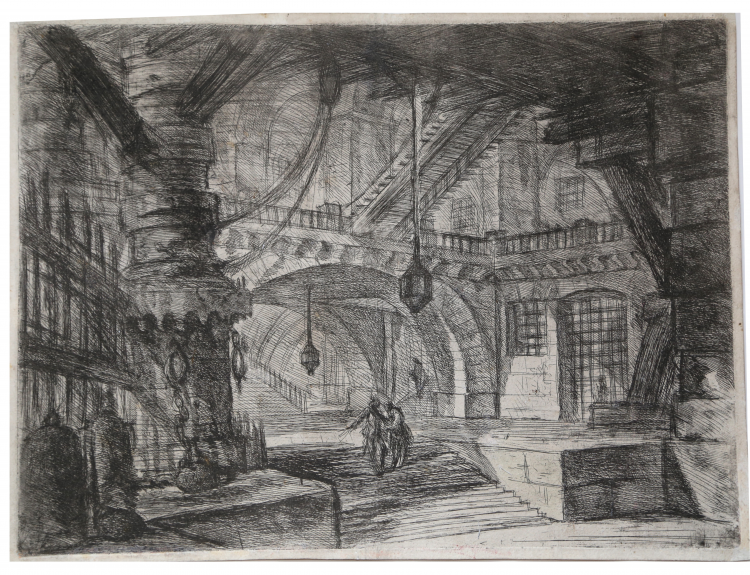





| Reference: | S31759 |
| Author | Giovan Battista PIRANESI |
| Year: | 1750 ca. |
| Measures: | 557 x 410 mm |




| Reference: | S31759 |
| Author | Giovan Battista PIRANESI |
| Year: | 1750 ca. |
| Measures: | 557 x 410 mm |
- THE VERY RARE FIRST STATE, from the FIRST EDITION of CARCERI -
Etching, engraving, sulphur tint and burnishing, 1750, signed at lower right. From the Carceri set, from the first edition, first issue.
Example in the first state of six described by Robison, from the contemporary roman edition.
A magnific impression, printed with black ink on contemporary thik laid paper, with small margins (about 8 mm), very good condition.
The first edition of 'Carceri' is absolutely rare. According with Andrew Robison, there are only 16th complete set of the first edition and first issue preserverd in the libraries.
Undoubtedly these is the best known and most celebrated series among the works by Piranesi. The series, datable around 1745, consisted of fourteen plates, with the title page bearing the title Invenzioni Capric di Carceri all’acquaforte datte in luce da Giovanni Buzard in Roma, mercante al Corso.
In the second issue, immediately subsequent, the title presents the publisher’s name rightly corrected in Bouchard. There is no doubt that the innovative idea of this work comes from a very close connection with the series titled Prima Parte di Architetture not only for the proximity of the dates, but also because both the series reflect the Piranesi’s precise ideology on architecture.
The series was re-published fifteen years later , in 1761.
|
Robison 42 I/VI, Hind 16, Focillon 39.
|
Giovan Battista PIRANESI (Mogliano Veneto 1720 - Roma 1778)
|
Italian etcher, engraver, designer, architect, archaeologist and theorist. He is considered one of the supreme exponents of topographical engraving, but his lifelong preoccupation with architecture was fundamental to his art. Although few of his architectural designs were executed, he had a seminal influence on European Neo-classicism through personal contacts with architects, patrons and visiting artists in Rome over the course of nearly four decades. His prolific output of etched plates, which combined remarkable flights of imagination with a strongly practical understanding of ancient Roman technology, fostered a new and lasting perception of antiquity. He was also a designer of festival structures and stage sets, interior decoration and furniture, as well as a restorer of antiquities. The interaction of this rare combination of activities led him to highly original concepts of design, which were advocated in a body of influential theoretical writings. The ultimate legacy of his unique vision of Roman civilization was an imaginative interpretation and re-creation of the past, which inspired writers and poets as much as artists and designers.
|
|
Robison 42 I/VI, Hind 16, Focillon 39.
|
Giovan Battista PIRANESI (Mogliano Veneto 1720 - Roma 1778)
|
Italian etcher, engraver, designer, architect, archaeologist and theorist. He is considered one of the supreme exponents of topographical engraving, but his lifelong preoccupation with architecture was fundamental to his art. Although few of his architectural designs were executed, he had a seminal influence on European Neo-classicism through personal contacts with architects, patrons and visiting artists in Rome over the course of nearly four decades. His prolific output of etched plates, which combined remarkable flights of imagination with a strongly practical understanding of ancient Roman technology, fostered a new and lasting perception of antiquity. He was also a designer of festival structures and stage sets, interior decoration and furniture, as well as a restorer of antiquities. The interaction of this rare combination of activities led him to highly original concepts of design, which were advocated in a body of influential theoretical writings. The ultimate legacy of his unique vision of Roman civilization was an imaginative interpretation and re-creation of the past, which inspired writers and poets as much as artists and designers.
|